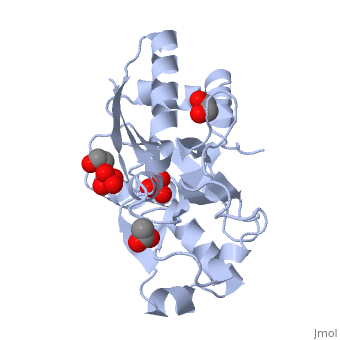ModG
From Proteopedia
(Difference between revisions)
(New page: {{STRUCTURE_1h9j| PDB=1h9j | SCENE= }} __TOC__ =Introduction to ModG= ModG is a cytoplasmic molybdate-binding protein exclusive to the aerobic nitrogen-fixer ''Azobacter vinelandii''.<ref...) |
|||
| (9 intermediate revisions not shown.) | |||
| Line 1: | Line 1: | ||
| - | + | ||
| + | <StructureSection load='1atg' size='350' side='right' caption='Molybdate-binding protein complex with tungstate, ethylene glycol, acetate and sulfate (PDB entry [[1atg]])' scene=''> | ||
__TOC__ | __TOC__ | ||
=Introduction to ModG= | =Introduction to ModG= | ||
| - | ModG is a cytoplasmic molybdate-binding protein exclusive to the aerobic nitrogen-fixer ''Azobacter vinelandii''.<ref name="MODGR1">PMID:11352591</ref> Molybdate is a molybdenum oxyanion (MoO42-). The group 6 element molybdenum is required by many enzymes that catalyze reactions associated with carbon, nitrogen, or sulfur metabolism.<ref name="MODGR2">PMID:21454640</ref> It is also part of the cofactor of the molybdoenzyme ModG. Not surprisingly, studies have linked ModG to molybdenum homeostasis within the cell.<ref name="MODGR1"/> | + | '''ModG''' is a cytoplasmic molybdate-binding protein exclusive to the aerobic nitrogen-fixer ''Azobacter vinelandii''.<ref name="MODGR1">PMID:11352591</ref> Molybdate is a molybdenum oxyanion (MoO42-). The group 6 element molybdenum is required by many enzymes that catalyze reactions associated with carbon, nitrogen, or sulfur metabolism.<ref name="MODGR2">PMID:21454640</ref> It is also part of the cofactor of the molybdoenzyme ModG. Not surprisingly, studies have linked ModG to molybdenum homeostasis within the cell.<ref name="MODGR1"/> |
=Structure= | =Structure= | ||
| - | + | ||
The molybdoenzyme is a homotrimer.<ref name="MODGR1"/> It can bind up to 8 molybdate molecules between 4 different types of <scene name='Sandbox_Reserved_306/1h9j/4'>active sites</scene> on subunit interfaces (BS1, BS1’, BS2, and BS2’). Binding site 1 and binding site 2 are found at opposite ends of the protein; binding site 1’ and binding site 2’ are found off-axis near like ends.<ref name="MODGR3">PMID:9862806</ref> The sites are connected by hydrogen bonds and thus a cooperative binding mechanism has been proposed for ModG whereby ligand engagement with type 2 sites induces conformational changes to asparagine residues at type 1 sites, reading the site for ligand interactions.<ref name="MODGR4">PMID:7665518</ref> The structure of ModG was solved by Delarbe et al. using multi-wavelength anomalous dispersion (MAD).<ref name="MODGR5"/> Crystallization required salt-free conditions established with polyethylene glycol (PEG), at which point the authors solved the PEG crystal form using molecular replacement.<ref name="MODGR5"/> | The molybdoenzyme is a homotrimer.<ref name="MODGR1"/> It can bind up to 8 molybdate molecules between 4 different types of <scene name='Sandbox_Reserved_306/1h9j/4'>active sites</scene> on subunit interfaces (BS1, BS1’, BS2, and BS2’). Binding site 1 and binding site 2 are found at opposite ends of the protein; binding site 1’ and binding site 2’ are found off-axis near like ends.<ref name="MODGR3">PMID:9862806</ref> The sites are connected by hydrogen bonds and thus a cooperative binding mechanism has been proposed for ModG whereby ligand engagement with type 2 sites induces conformational changes to asparagine residues at type 1 sites, reading the site for ligand interactions.<ref name="MODGR4">PMID:7665518</ref> The structure of ModG was solved by Delarbe et al. using multi-wavelength anomalous dispersion (MAD).<ref name="MODGR5"/> Crystallization required salt-free conditions established with polyethylene glycol (PEG), at which point the authors solved the PEG crystal form using molecular replacement.<ref name="MODGR5"/> | ||
| Line 30: | Line 31: | ||
=Fate= | =Fate= | ||
ModG is eventually degraded and incorporated into molybdopterin, a cofactor of molybdenum enzymes, or the iron-molybdenum cofactor of a nitrogenase enzyme.<ref name="MODGR1"/><ref name="MODGR2"/> Currently there is little known about cofactor biosynthesis involving the ModG protein.<ref name="MODGR1"/> | ModG is eventually degraded and incorporated into molybdopterin, a cofactor of molybdenum enzymes, or the iron-molybdenum cofactor of a nitrogenase enzyme.<ref name="MODGR1"/><ref name="MODGR2"/> Currently there is little known about cofactor biosynthesis involving the ModG protein.<ref name="MODGR1"/> | ||
| + | </StructureSection> | ||
| + | =3D structures of ModG= | ||
| + | |||
| + | [[1h9j]] – AvModG + phosphate + molybdate – ''Azotobacter vinelandii''<br /> | ||
| + | [[1atg]] – AvModG + tungstate + sulfate + acetate<br /> | ||
| + | [[1h9k]] - AvModG + tungstate + phosphate<br /> | ||
| + | [[1h9m]] - AvModG + molybdate | ||
=References= | =References= | ||
| Line 37: | Line 45: | ||
=See also= | =See also= | ||
[[Category:Molybdenum-containing enzyme]] | [[Category:Molybdenum-containing enzyme]] | ||
| - | + | [[Category:Topic Page]] | |
This page originally authored by Corbin Black | This page originally authored by Corbin Black | ||
Current revision
| |||||||||||
3D structures of ModG
1h9j – AvModG + phosphate + molybdate – Azotobacter vinelandii
1atg – AvModG + tungstate + sulfate + acetate
1h9k - AvModG + tungstate + phosphate
1h9m - AvModG + molybdate
References
- ↑ 1.00 1.01 1.02 1.03 1.04 1.05 1.06 1.07 1.08 1.09 1.10 1.11 Delarbre L, Stevenson CE, White DJ, Mitchenall LA, Pau RN, Lawson DM. Two crystal structures of the cytoplasmic molybdate-binding protein ModG suggest a novel cooperative binding mechanism and provide insights into ligand-binding specificity. J Mol Biol. 2001 May 18;308(5):1063-79. PMID:11352591 doi:10.1006/jmbi.2001.4636
- ↑ 2.0 2.1 2.2 2.3 2.4 2.5 2.6 Yang ZY, Dean DR, Seefeldt LC. Molybdenum nitrogenase catalyzes the reduction and coupling of CO to form hydrocarbons. J Biol Chem. 2011 Mar 28. PMID:21454640 doi:10.1074/jbc.M111.229344
- ↑ 3.0 3.1 3.2 3.3 3.4 3.5 3.6 Lawson DM, Williams CE, Mitchenall LA, Pau RN. Ligand size is a major determinant of specificity in periplasmic oxyanion-binding proteins: the 1.2 A resolution crystal structure of Azotobacter vinelandii ModA. Structure. 1998 Dec 15;6(12):1529-39. PMID:9862806
- ↑ 4.0 4.1 4.2 4.3 4.4 4.5 4.6 Mouncey NJ, Mitchenall LA, Pau RN. Mutational analysis of genes of the mod locus involved in molybdenum transport, homeostasis, and processing in Azotobacter vinelandii. J Bacteriol. 1995 Sep;177(18):5294-302. PMID:7665518
- ↑ 5.0 5.1 5.2 5.3 Williams CE, White DJ, Delarbre L, Mitchenall LA, Pau RN, Lawson DM. Crystallization and preliminary X-ray studies on the molbindin ModG from Azotobacter vinelandii. Acta Crystallogr D Biol Crystallogr. 1999 Jul;55(Pt 7):1356-8. PMID:10393312
See also
This page originally authored by Corbin Black

